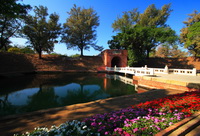
Eternal Golden Castle was called "Anping Great Fort" or "Twice Fish Length Fort" in the ancient time, it was built to resist the Japanese troops who invaded Taiwan due to Peony Suffix Event. When Shern Bao-Tzen first arriving in Anping in 1874, he believed that Great Forts should be built to protect the city, therefore, the first western style fort was finally completed in 1876, which was designed by French engineers, it was the first port equipped with British Armstrong Cannon in Taiwan, moreover, it was a great step toward modernization of Taiwanese coastguard military defense. On the construction form, Eternal Golden Castle is a square shape fort belongs to the western diamond type castle, with its four corners protruding, and its center indenting. There are fosses around the fort, and the fort is placed with big and small cannons, while the center of the port is used as exercising field; the shape is of integrity and complete, the scale is huge, supported with powerful fort, Eternal Golden Castle can be seen as the important epoch-making milestone among all forts in Taiwan. The fort was ruined later on, and was once neglected, but later it was ranked among one of the noted sights in the city and was carefully reserved. After the restoration, a major reconstruction was carried out, the shape and the materials were more or less changed. But after the reconstruction, the original scale can generally be seen. Nowadays, the Eternal Golden Castle is ranked as first degree historic spot, its outer walls are about two meters high, the fosses are around the castles walls, trees and woods are thickly growing, the bricks laying arched castle gate is 5 meters high, through the arched castle gate, what you can see is a carpet of green grass, flat and wide, there are also memorial brass sculpture of Shern Bao-Tzen and imitated ancient cannons.